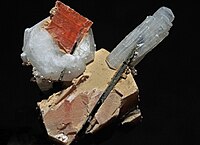
Photo from wikipedia
AbstractMagnetic mineral inclusions in silicates are widespread in sediments as well as in igneous rocks. Because they are isolated from surrounding environment, they have potential to preserve original magnetic signature… Click to show full abstract
AbstractMagnetic mineral inclusions in silicates are widespread in sediments as well as in igneous rocks. Because they are isolated from surrounding environment, they have potential to preserve original magnetic signature even in chemically altered sediments. Such inclusions may provide proxies to help differentiating the source of the host silicate. We measure magnetism of quartz and feldspars separated by chemical digestion of pelagic red clay. The samples are from the upper 15 m of sediments recovered at Integrated Ocean Drilling Program Site U1366 in the South Pacific Gyre. The quartz and feldspars account for 2.3–22.7 wt% of the samples. X-ray diffraction analyses detect both plagioclase feldspar and potassium feldspar. Plagioclase is albite-rich and abundant in the top ~ 7.4 m of the core. Potassium feldspar mainly occurs below ~ 10.4 m. The dominance of albite-rich plagioclase differs from a previous investigation of coarser fraction of sediments from the South Pacific. Saturation isothermal remanence (SIRM) intensities of the quartz and feldspars are 7.45 × 10−4 to 1.98 × 10−3 Am2/kg, accounting for less than 1.02% of the SIRM of the untreated bulk samples. The depth variations of the silicate mineralogy and the previously reported geochemical end-member contributions indicate that quartz and/or plagioclase above 8.26 m is likely to be Australian dust. In contrast, the relative abundance and the magnetic properties of quartz and feldspars vary below 10.42 m, without clear correlation with geochemical end-member contributions. We consider that these changes trace a subdivision of the volcanic component. Our results demonstrate that magnetism of inclusions can reveal additional information of mineral provenance, and chemical separation is an essential approach to reveal the environmental magnetic information carried by magnetic inclusions.
Journal Title: Earth, Planets and Space
Year Published: 2018
Link to full text (if available)
Share on Social Media: Sign Up to like & get
recommendations!